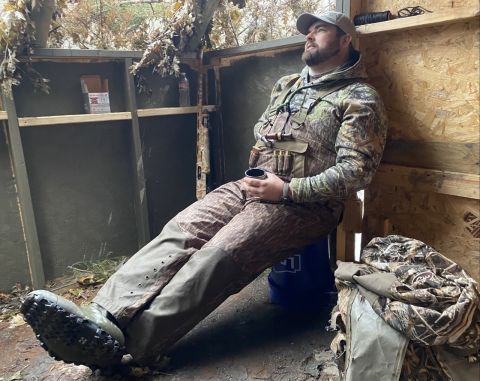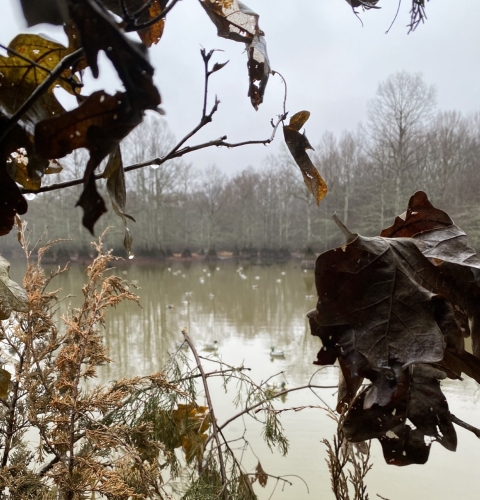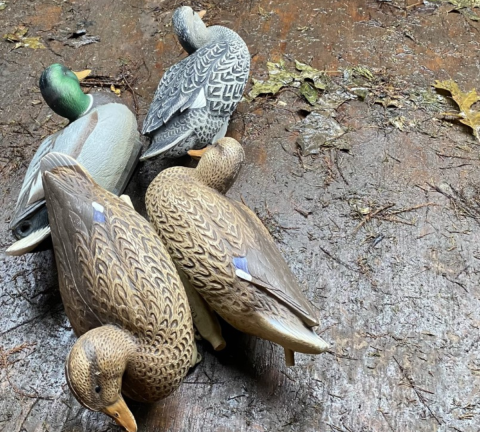Dyersburg, Tennessee – It’s a half hour to sunrise and go-time for the half-dozen duck hunters anxious to lure mallards to their floating blind sitting low in an oxbow of the Forked Deer River.
Four hours later, they’re still waiting.
There were, to be sure, a couple of times in between when the men jumped to their feet, pointed skyward, grabbed duck calls, and fingered shotguns in anticipation of downward spiraling mallards, gadwalls, wigeons and pintails. To no avail.
Blame it on the too-dry December weather -- or climate change climate change
Climate change includes both global warming driven by human-induced emissions of greenhouse gases and the resulting large-scale shifts in weather patterns. Though there have been previous periods of climatic change, since the mid-20th century humans have had an unprecedented impact on Earth's climate system and caused change on a global scale.
Learn more about climate change . A slew of factors, including the farming of different crops, are causing duck harvest numbers to plummet along the southern reaches of the Mississippi Flyway. But the telltale signs of an increasingly angry Mother Nature -- warmer temperatures, droughts, wacky precipitation patterns – abound.
Ducks aren’t the only hunted critters experiencing the impacts of a warming world. Less snow means elk stay longer, and higher, in the mountains browsing on plants and grasses while delaying migration to prime hunting grounds. More heat, droughts, and floods harm trout and salmon habitat while opening the door to more adaptable invasive fish that squeeze out the native species. Deer and moose succumb to blood-sucking ticks that don’t die when the temperatures don’t stay cold enough long enough.
Duck hunting is a near-religion in the South. The bayous of Louisiana, the wetlands of North Carolina, the rice fields of Arkansas, the flooded timberlands of Tennessee – all entice hunters to get out of bed at 3 a.m., drive two hours to a cold, wet blind, and pray that the pinkening sky will fill with waterfowl. Stuttgart, Arkansas, after all, is known as the “duck capital of the world.” Two of the nation’s four migratory flyways funnel dabblers and divers into the deepest South, from Louisiana to Florida.
The southern skies, though, are less crowded these days.
“I am surprised by the lack of wood ducks this morning,” said Heath Hagy, a waterfowl ecologist with the U.S. Fish and Wildlife Service as the first two hours of hunting pass without a shot at the Tigrett Wildlife Management Area. “Usually, they come early. It’s disappointing.”
Hagy, then, switches from hunter to scientist.
“Where we can see the biggest impacts on mallard movements are north from the Gulf Coast,” he said. “There are very few mallards that go to southern Louisiana now compared to 30 years ago. The northern portion of their wintering range hasn’t really moved that far north, but the southern extent has moved hundreds of miles to the north.”
The further north, the better
Ducks and other waterfowl live most of the year up north around the Great Lakes and Canada before heading south for the winter down the Mississippi River. Of the nation’s four flyways, the Mississippi is home to nearly half of the country’s duck hunters who account for 40 percent of birds harvested annually, according to Ducks Unlimited.
But there are fewer birds of late. In 1999, for example, an estimated 7.6 million ducks were harvested by hunters across the entire flyway, according to the most recent Waterfowl Harvest and Population Survey Data compiled annually by Fish and Wildlife. (The Service is the federal agency responsible for migratory bird health and abundance.) In 2021, only 3.7 million ducks were taken.
Scientists caution, though, that fewer hunters translate into fewer harvests. So, the waterfowl survey tallies how many birds an “active duck hunter” bags each year. An Arkansas hunter, for example, bagged 25.4 ducks in 1999. Two years ago: 16.2 ducks.
The further north, the better the chances. In Minnesota, a hunter could expect to bag 8.6 ducks per year in 1999. In 2021: 7.8 ducks.
Rising temperatures – the most noticeable hallmark of climate change – greatly affect duck behavior. Put simply, if it’s warm enough, and snow and ice don’t cover the fields and ponds, ducks don’t have to fly hundreds of miles southward for food. Minnesota has warmed three degrees Fahrenheit since 1895 – with the top 10 warmest years all coming after 1998.
The National Audubon Society and Clemson University released a study in 2021 tracking migration patterns for 16 duck species that winter in the Southeast. Researchers combined the annual Christmas Bird Count with average winter temperature changes over the last half century. Twelve of the duck species, including mallards, American black ducks, and northern pintails, spent more time in the north and less time in the South.
“We’ve suspected that warming temperatures are changing the types of waterfowl that we’re seeing in different regions, and these data confirm that,” said Tim Meehan, quantitative ecologist at the National Audubon Society. “The weather has stopped becoming severe enough in the winter to prompt the birds to fly south. They’re staying farther north, and they’re telling us that something fundamental has changed in their environment.”
The diminishing duck range tracks closely with shifts Audubon noted a few years earlier for 305 North American bird species. The birds’ “mean center of winter abundance” moved northward by 60 or more kilometers between 1966 and 2013.
“Things have definitely changed”
Christmas bird counts, which rely on citizen-birders to tally the numbers and locations of various species, aren’t necessarily the best barometers of duck migration. Most counters, for example, live in more urban areas outside the rural realm where ducks seek food, water, and shelter. Hagy, and colleagues with Ducks Unlimited and the University of Missouri, are researching more closely the timing of migration patterns and which species are most impacted.
Lisa Webb, a professor, and Bram Verheijen, a postdoctoral fellow, scoured 60 years of bird-banding and harvest data across the Mississippi and Central flyways to discern when, and where, 15 species of ducks come south. In the 1960s, for example, ducks in great numbers headed all the way down to Louisiana and Texas. Decades later – after years of steadily rising temperatures across the Great Plains and the Great Lakes – the flocks didn’t travel as far.
Migration during the typically colder months of duck season proved particularly illustrative, according to the soon-to-be-published report. Mallards, for example, shifted their January "center of distribution” -- the duck hot spot -- between 260 and 325 kilometers to the north along the flyways. (They’re also more widely distributed to the east and west.) That’s about the distance from New Orleans to Vicksburg.
“When we presented the results at the Mississippi Flyway meeting last winter, I remember Louisiana’s waterfowl biologist saying, ‘That lines up with what we’re seeing,’” Webb said.
Hagy agreed.
“Things have definitely changed,” he said moments after a skein of mallards circled down, flew north, and circled back before flying off. “Hagy and friends were duck-less after three hours in the blind. “Those birds stay further north as long as possible. The ice cover on the Great Lakes is greatly diminished year after year for the last 50 years. Perhaps as many as thirty to forty percent of ducks are really driven by ice and snow cover, so there’s less incentive to go south in warmer years. And some populations of sub-arctic breeding geese rarely get past Chicago now. They used to be here and in the Gulf.”
Verheijen, though, cautions that the science hasn’t yet proven that climate change is the main factor in the disappearance of Deep South ducks. If it’s warm, but doesn’t rain, for example, birds will still have to fly south for sustenance.
“A correlation can easily be made, but it’s not necessarily a causal relationship,” he said.
A changing landscape
The researchers will next link timing, distribution, and weather data to land use, wetlands loss, hunting regulations, and other on-the-ground metrics to paint a more detailed picture of the duck drop-off.
“Any time you look at changes in migratory behavior and distribution behavior it will be driven by a number of different factors,” said Mike Brasher, the senior waterfowl scientist for Ducks Unlimited. “While we have had changes in weather over a long period of time, there have also been changes in the landscapes that those birds interact with.”
Case in point: rice farming. Ducks love rice paddies, dabbling in the shallow water for bits of grain, seeds, and invertebrates, especially with the loss of millions of southern acres of freshwater wetlands and coastal marshes. Now, though, rice production is dwindling. Six decades ago, 930,000 acres of rice was planted in coastal regions of Texas and Louisiana. About half remains today.
“One of the starkest things I’ve seen in north-central Mississippi where I grew up, and it’s really intensified, is the change of landscape,” said Brasher who duck hunts maybe 15 days a year. “The interior, the rivers, and the floodplains held a lot of birds. But that part of the state has been converted, first to soybeans and then to sweet potatoes which don’t have any foraging value for waterfowl.”
Ducks Unlimited, the U.S. Fish and Wildlife Service, and a slew of other agencies spend millions annually to boost waterfowl habitat. One thing they can’t control, though, is the weather. Low winter temperatures in Minnesota, for example, could be seven degrees warmer in 2050 than they were in 2000 if greenhouse gas emissions don’t drop significantly. And that means fewer days below freezing, lakes that don’t ice over, less snow, and “delayed autumn-winter migration,” according to a 2016 study published in the scientific journal PLOS ONE.
“Indeed, the mallard, the most common and widespread duck in North America, may overwinter in the Great Lake region by the late 21st century,” the report concludes.
Hagy isn’t ready to call it quits on mallards. Nor on the day’s hunt. Up the hunters jumped when the telltale sounds of a flock high overhead penetrate the day’s fog and gloom. Six men set to their duck calls, a cacophony of quacks, squeaks, and squeals. Down circled the ducks.
“Here we go,” a hunter said.
A barrage of gunfire. A duck is winged. Hagy finished him off.
“Hey guys,” he said, “we got a bird.”
A gadwall. A drake. The day’s only duck.
This story is part of a collaborative effort to explore how climate change is impacting hunting and fishing across the United States.






